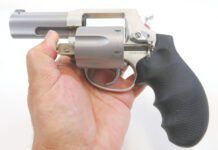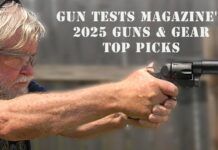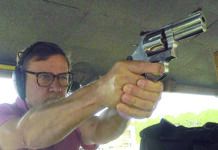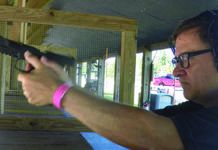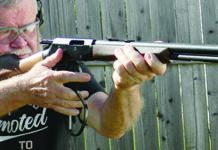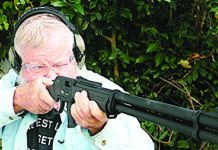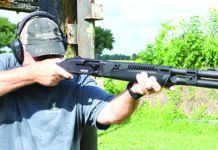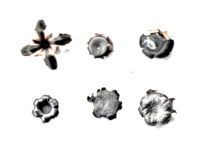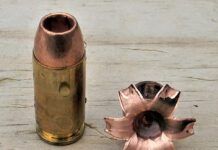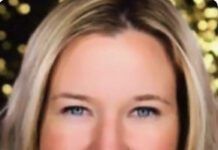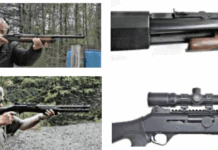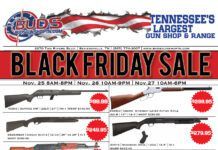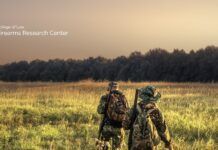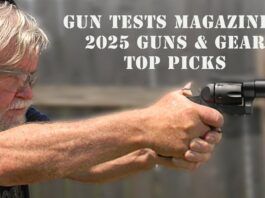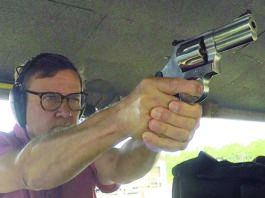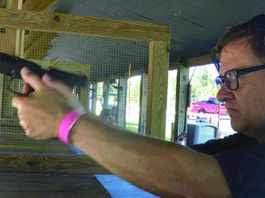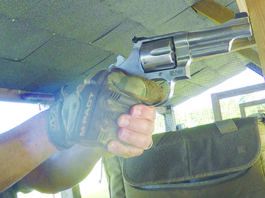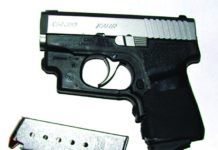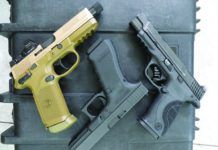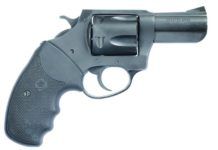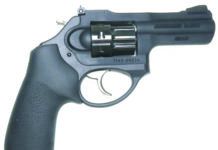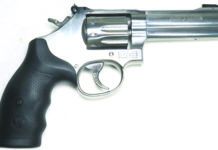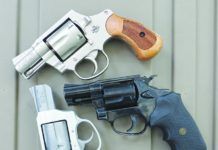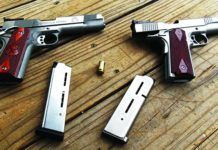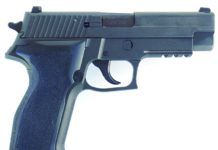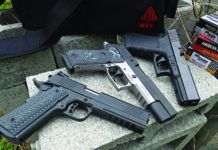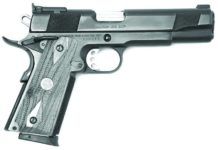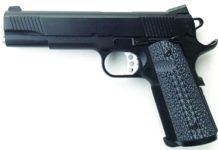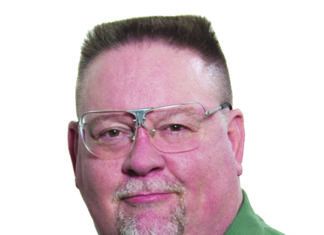Folks Liked the 380 ACP Review
While you didn't like the sights, short grip, or the long DAO trigger of the Kahr CW380, I loved all of them when comparing this gun to the others available at the time, especially the long smooooooth trigger. What a wonderful trigger the Kahr has! Once I bought it, I began adapting it to my own needs and use. First, I added two additional magazines and a pair of Pearce grip extenders, then added a Hogue rubber grip. The Pearce grip extenders allow me to get all three fingers on the grip, and the Hogue makes it extremely comfortable. Next I added a Crimson Trace laser for low-light situations. Now, I have what I consider to be a perfect pocket pistol. It is invisible in a pocket holster. Sorry to disagree, but IMHO, the LCP doesn't come close to my Kahr. I suggest everyone adapt whatever they buy/use to their hands, eyes, stance, needs, and abilities to maximize its utility. Then practice, practice, and practice.
Optics-Ready: M&P9 Ported, FNX-45 Tactical, G17 Gen4 MOS
If there is one new trend taking hold of pistol manufacturers, it is making optics-ready pistols. These handguns come out of the factory with the ability to mount a reflex-style red dot sight. The newest is the Glock G17 Gen4 MOS, which debuted in 2016. Kahr, SIG, and the Canik from Century Arms may also see optics-ready models in 2016. Custom gun makers have been crafting pistols with reflex sights for years, and back in 2012, both S&W and FN launched optics-ready pistols. Just like Picatinny rails have emerged as a widespread feature and laser pointers are being offered on many handgun variants, the optic mount is the next evolution of the handgun. We have seen this same scenario play out with AR rifles, where optics were once an anomaly and they are now the norm. Why? Ease of aiming and faster target acquisition. What, perhaps, has slowed the trend is cost. Reflex sights can add anywhere from $240 to $600 extra, depending on the sight. There may also be a need to purchase a new holster to accommodate the optic on the handgun and taller iron sights. This seems a little odd to us because many shooters might consider the cost to be excessive on a handgun, but we don't think twice about mounting a high-quality optic on a rifle. There is no doubt that in the same situations, red-dot reflex sights allow users to aim faster and easier compared to iron sights. Also, reflex sights allow users to aim with both eyes open, peering through a small glass lens that the sight uses to project a reticle onto it via a light-emitting diode. The sight provides an unlimited field of view since there is no magnification and no tube, so tunnel vision is less of an issue when aiming. Also, there is also no need to align three planes — target, front sight, and rear sight — as with iron sights. However, during testing, we found that taller iron sights that co-witnessed with the red dot were preferred because they can help find the dot. Also, BUIS are there in case the optic fails or the battery dies when we need it most. A proper maintenance schedule can alleviate this concern. To see how various red dots could be mounted and used on factory optics-ready pistols, we acquired a Glock G17 Gen4 MOS, an S&W M&P9 Performance Center Ported model, and an FN America FNX-45 Tactical FDE. The Glock and S&W were 9mm striker-fired pistols that are well known to us. We have reviewed numerous Glock G17 models over previous model generations, but this is first G17 Gen4 MOS that our testers have evaluated. The same is true with the S&W M&P9. We have tested other variants of the M&P9, but this is a first for the S&W M&P9 Performance Center Ported model. The 45-caliber FNX-45 Tactical is also new to our testers. What we were looking for with these optics-ready pistols was ease of installation, accuracy, ease of use, and durability.
Snubbies, the Taurus Recall, and Trump on Guns
Regarding the Taurus settlement and the problems Lou had with his pistol: On August 4, 2015 I sent Taurus my PT-111 Pro and two magazines. Their website was very poor about updating progress of the return, but by 12/16/2015 I did have a new PT-111 G2 with two mags, all new in the box. I had to pay $25 for the FFL transfer fee, but I was reimbursed by 1/15/16. I am actually quite pleased with the new gun. To get reimbursed, I faxed an itemized receipt to Taurus at (305) 624-1126. I hope this helps Lou and perhaps others.
Ruger LCRx 5435 22 LR
Taurus 992 Tracker 2-992049 22 LR/22 WMR
Smith & Wesson Model 617-6 160584 22 LR
$400 Snubnose Revolvers: Rossi, RIA, and Charter Arms
We felt all of these were well made, and we believe these revolvers will perform their designed task of self defense. They are also safe to carry fully loaded and concealed, since they are equipped with internal safety systems that require the trigger to be pulled fully to the rear to fire a round. If accidentally dropped, none of them will fire.
Snubnose revolvers like these three offer the user simplicity since there are no manual safeties, magazine-release buttons, slide stops or any other controls on the revolver other that the cycler latch. There is no magazine to lose since the revolver feeds off an attached cylinder. The double-action trigger pull on all three revolvers provided enough resistance — some were easier to press than others — so that in a high-stress situation, we felt they would be quite adequate and be less likely to be accidentally discharged.
All were metal-frame revolvers chambered in 38 Special and sported 2-inch barrels. The Rossi and Charter Arms models have 5-round capacities, while the RIA can carry 6 rounds. Because we also wanted to carry these revolvers, we looked at spurless and concealed-hammer models, which were the RIA and Charter Arms, respectively. The Rossi was a traditional SA/DA revolver with an exposed hammer with spur.
After running these revolvers, we found we liked a lot about all of them, but, as always, we noted some specific details about them we did not like. Our biggest gripes were the trigger pulls and grips, as we note below. Accuracy with some of these short-barrel protectors was a pleasant surprise.
All three were marked 38 Special, and we read the manuals to see if the guns were safe to use +P ammo. The Rossi manual stated it was compatible with +P ammo, but not to use +P frequently. We decided to test with 38 Special regular-pressure ammunition only, and acquired some Federal Champion 158-grain lead roundnose (LRN) cartridges, some Armscor 158-grain Full Metal Jacket (FMJ) rounds, and Hornady Custom fodder loaded with 158-grain XTP hollowpoints. Felt recoil with this ammunition varied widely.
A $400 revolver will exhibit some characteristics, such as fit and finish, that are not going to be nearly as nice as a revolver costing twice as much because finishing a firearm can be labor intensive and costly. What we concentrated on were the functional aspects: triggers, sights, grips, accuracy, concealability, and ease of use. Here is what we discovered.
Practical Target Guns: Kimber And Springfield Go Head to Head
In this installment, we pit two practical target guns against each other. By practical target guns we mean accurate and useful 1911 handguns suitable for personal defense, hunting, and some forms of competition. They are not so specialized that they are not holster guns or unreliable for general use. Some target guns simply are not as robust as these handguns.
Fragile sights that overhang the slide too far, as an example, are counterintuitive in an all-round packing gun. If an adjustable sight loses its zero in competition, you will lose the match. Losing zero in a personal-defense situation carries a stiffer penalty for failure. Getting down to the nitty-gritty, fiber-optic front sights are not always desirable in a hard-use handgun because they tend to be fragile, even if they deliver superior targeting performance.
On the other hand, a service pistol or a hunting pistol with adjustable sights is desirable given the wide range of bullet weights and velocity available with the 45 ACP cartridge.Gun Testsreaders already know that the 1911 Government Model platform is a versatile, go-anywhere do-anything handgun; but the question is, can target performance translate to defensive reliability and handling?
When the National Matches got into full force after World War One, improvements were undertaken on the 1911 handgun. Barrels were welded up and carefully fitted, and high-profile sights were fabricated. These improvements led to the Colt National Match pistol's introduction in 1933. The National Match featured a hand-honed action and two-way adjustable sights. Law officers and outdoorsmen also adopted this relatively expensive handgun. Changes and modification led to the Colt Gold Cup. The sights were fragile in many renditions — not the case in the newest models — so the shooter wishing to own a service-grade handgun with target sights had to take the custom route. Expedients, such as fitting Smith & Wesson revolver sights to the 1911 slide, were not always successful, but the Bo-Mar sight was an excellent addition to any 1911.
High-visibility adjustable sights are a good thing to have, provided they are reliable in keeping zero, are not fragile, and aren't likely to be damaged. Today, we have the best adjustable-sight 1911 pistols yet from the factory, and our two tests guns put them to excellent use. Here's how they performed.
40 S&W Shoot Out: Beretta, CZ-USA, Ruger, and SIG Sauer
Pistols chambered for the 40 S&W round often are the odd man out as the first choice of a citizen contemplating arming himself or herself. Most of us choose the 45 ACP for its terminal performance and the 9mm Luger for capacity. Here, though, this report is in part a continuation of 40-caliber ammunition tests we conducted some years ago. One of our raters has much field experience and favored the 45 ACP and did not give the 40 S&W much attention.
After empirical testing, he came to the conclusion that the 40 is more like the 45 than the 9mm in terminal ballistics, and that's a good place to be. This rater also tested compact and subcompact 40-caliber pistols and came away believing that forties lighter and smaller than the Glock 23 are too much for most shooters to handle well. So, it was logical that he gravitated toward service-size 40 S&W handguns as the right fit of cartridge and pistol.
Full-size handguns are among the most common 40 S&W handguns chosen for home and personal defense. They are relatively mild to fire and reliable.
With these facts in mind, we wanted to test four 40-caliber handguns of different configurations to see which one suited our testers the best. Also, we went looking for value, shooting two brand-new guns against veterans which, perhaps, still had some game left in them. The two new guns were a selective-double-action CZ 75B and the double-action-only Ruger SP40, which we found listing around $580 and $569, respectively. The other choices were the double-action first-shot SIG P226R and the double-action first-shot Beretta 96 Vertec Inox, the latter a used model and the former was a factory rebuild offered by SIG Sauer.
The Beretta Model 96 Vertec has received praise from us before, being named a Gun of the Year in 2005 after being evaluated in the April 2005 issue. We said then, "Alloy 40 S&W pistols have a well-earned reputation for packing plenty of power in their lightweight frames, but they are also well-known for being vicious kickers for the training shooter. However, the Model 96 Vertec was an exception." In particular, we liked the vertical grip design that, combined with the thinner grip panels and short-reach trigger, made the pistol much friendlier to shooters with smaller hands. We liked it because its flat-sided feel and more rectangular shape were easier to index, that is, get in proper alignment faster. This time we tested the stainless version.
Certified Pre-Owned SIG Sauer pistols like the P226R tested here are often traded in by law-enforcement agencies for new SIGs, and the company puts the pre-owned SIG pistols through a stringent Factory Certification process. Each pistol is stripped, refitted with original factory parts where needed, cleaned, lubricated, function tested and hand-inspected by a factory technician. Each Factory Certified pre-owned SIG comes with a one-year warranty and one standard-capacity magazine. The condition of these pistols will vary depending on the amount of wear, such as that caused by a holster and ring wear, and that condition will be reflected in the retail price. Dings and holster wear and ring scratches are not covered under the one-year factory warranty.
We tested a similarly set up CZ 75Bpreviously (May 2009), but chambered in 9mm. In that test we noted the accuracy of the CZ was about 2.5 inches for all shots fired at 15 yards. We also noted the heavy CZ dampened 9mm recoil, and there were no problems with the CZ whatsoever. It appeared to be very well made and built to last. We looked forward to testing the 40 S&W version.
Likewise,we tested a Ruger SR40previously, most recently in the October 2011 issue. In that review, we said, the SR40 was remarkably underrated, and it might be a plastic gun for people who don't like plastic guns. We said, "Its slender profile makes it more controllable than most high-capacity guns, and it's a good candidate for concealed carry, too. We liked having manual safeties even if they weren't perfect. Though not match grade, we thought the trigger was predictable with a reasonable sense of take-up and overtravel." That model was the BSR40, with an all-black color scheme and a 15+1 capacity, which is now listed by the company as Model 3471. This new SR40 is Model 3470, still with the same 15+1 capacity, but this time with a brushed-stainless-steel slide.
Full-Size 10mm Pistols from SIG, Glock, and Rock Island Arsenal
The 10mm Auto cartridge seems to be going through a renaissance. There is new ammunition being manufactured in velocities the 10mm was intended for, like in the newer SIG Elite Performance ammo, and firearms manufacturers such as Glock and SIG have offered new pistols chambered in the round, the G40 Gen4 MOS and P220-10, respectively. We wanted to take a look at the 10mm in a full-size pistol that we could easily open-carry on the back 40 or concealed under a jacket or coat for in town. Since there are numerous examples of 10mm pistols to test, we also wanted to see if a different platform favored the big-bore caliber.
As we tested, we gained renewed respect for the 10mm round. Some testers even thought the round may be a liability in a self-defense situation due overpenetration. If we were in a crowded mall and were able to get solid center-of-mass hits on an attacker, we wondered whether certain loads would overpenetrate and hit a bystander. We do think it is a good round to punch through vehicles with and to stop big bears, and we also feel it is an excellent hunting cartridge if kept to bow-hunting distances on feral swine, whitetails, and small black bears. Around bystanders, we would most likely stick with the 10mm Lite or 10mm FBI loads if we carried the 10mm concealed.
The 10mm Auto creates a maximum pressure in the range of 37,500 psi. Compare that to the 45 ACP, which has about 21,000 psi with 230-grain ball ammo. The round was the brainchild of Jeff Cooper and a few like-minded individuals who wanted better terminal ballistics than the venerable 45 ACP could produce. The 10mm Auto exceeds 357 Magnum power and is very close to that of the 41 Magnum. The 10mm Auto is a brute of a round with the type of recoil you would expect from a magnum revolver. The mythical Bren Ten was one of the first semi-automatic pistols chambered in the round. The pistol never really lived up to its expectations due to magazine difficulties and the 10mm Auto thoroughly trouncing the Bren Ten's mechanism. The 10mm Auto has such a fast-moving bullet that it tends wreak havoc with the pistol's recoil mechanism. Colt first chambered its 1911 Series 80 in the cartridge in 1987, and it caused receivers to crack where the slide stop fits into the receiver. A relief cut was made by Colt to fix the situation, and the company's pistols in 10mm ran fine thereafter. When the FBI adopted the round after the Miami-Dade shoot out in 1986 due to agents' underperforming handgun cartridges, the Bureau soon realized agents could not or had a hard time handling the recoil of the 10mm Auto. The Bureau had adopted the cartridge first, then adopted the S&W Model 1076, which was purpose-built for the round. The FBI's solution was to load the 10mm light, which made it more tolerable to agents. The 10mm loads became known as 10mm Lite or 10mm FBI. We all know the light 10mm load is nothing but a 40 S&W in a longer case. The 10mm Auto produces about 300 foot-pounds more energy than the 40 S&W when the 10mm Auto is loaded to its standard velocity, and it's even hotter with niche ammo like that from Buffalo Bore. The 40 S&W changed the way law enforcement looked at cartridges, and the 10mm Auto might have been forgotten if it were not for some diehard fans — one of whom is on theGun Testsstaff.
Our shooters chose three very popular platforms to test the 10mm Auto: a 1911 design from Rock Island Arsenal (RIA), the SIG P220 model, which custom gunsmiths have been converting to 10mm for years, and the large Glock frame, which has been chambered in 10mm since 1991. All of these pistols in other calibers, namely 45 ACP, have received high grades in the past from us, so our expectation was these pistols would perform, and they did. All the pistols ran exceptionally well, with no malfunctions or jams. That says a lot because some 10mm Auto pistols are finicky because factory ammo is loaded light, standard, and heavy. We used an assortment of ammo; two light loads from Federal and two standard 10mm Auto loads from SIG in the Elite Performance Ammunition line, that are much faster than the Federal's load. The Federal loads consisted of American Eagle 180-grain FMJs which clocked slightly over 1000 fps, and Personal Protection 180-grain Hydra-Shok JHPs, which had an average muzzle velocity of slightly under 1000 fps. The SIG ammo averaged well over 1200 fps, except for the V-Crown 180-grain JHP in the Glock. The Glock showed lower velocity across the board with all the ammos compared to the SIG and RIA. Note the Glock barrel is also half an inch shorter than the RIA and SIG barrels.
More Laments for Custom Guns
Like Grant said in last month's letters section, I, too, lament the passing of the pride of custom-gun ownership and the common look of the Ubiquitous Black Gun. But, as was said, black guns are cheap and proven reliable. Also, I cannot justify carrying a nice custom pistol on the off chance that I might have to use it. In that case, I would have to surrender it to the police, and then it would be months at a minimum to maybe get it back by jumping through their hoops.
Yes, I would rather carry a "Rolex"-quality sidearm, but I often think that if I had to give up my Valtro, I'd don't know what I'd do.
A black gun I can give up with no emotion, and go home and get another one. I always enjoy the magazine, from the editorial remarks to the last page. — Dave
Four 45s Compete for Top Carry Honors
The high-end 1911 handgun continues to be popular, so popular, in fact, that folks are willing to drop well over one thousand dollars to gain what they hope is superior performance. On a high-end pistol, "performance" often means features, such as good sights, forward cocking serrations, a good trigger compression, and attention to detail. The discerning shooter is looking for reliability first, then handling, accuracy, and fit and feel, and four handguns that are reputed to have those qualities at various price tags come from Colt and Springfield Armory.
We recently tested two sidearms chambered in 45 ACP from each company that would interest nearly any buyer who was in the market for a self-defense arm. The products were Springfield's Loaded Model PX9109LP, $790; and for hundreds more, the company's Tactical Response Pistol, the TRP PC9108LP 45 ACP, $1347. To fit in that sizable price gap in the Springfield lineup, we selected Colt's Combat Elite 08011XSE, $1015, and the Rail Gun XSE 01070RG, $1199. These are actual counter prices from BudsGunShop.com, and our intent was to survey a range of pricing to see if additional dollars translated into additional performance that would matter to our test team of shooters.
Among the most popular sidearms in terms of numbers sold are the Colt Combat Elite and the Springfield Loaded Model. A Colt Rail Gun variant is used by the U.S. Marine Corps, and the Springfield Bureau Model, similar to the TRP, by the FBI SWAT team. All four are combat guns intended to give the user an advantage in the field, so our thorough test involved a number of trained shooters who were asked to push the pistols to the limit, so we could discover the boundaries of control, combat accuracy, and absolute accuracy. We should also note that the Loaded Model was a rater's personal carry gun. The rater stated it came out of the box running and has never given a complaint, and it has some 5,000 rounds through it. Cosmetically, it was hard to assess the status of the Loaded by just looking. The pistol is finished in a dull, non-reflective Parkerized finish that doesn't show wear very much. The other pistols were new out of the box.
At this point we will mention the holsters used, as the Rail Gun demanded rail-specific holsters. The other three guns were easily passed around to the raters and standard holsters were used for them. For the Rail Gun, we had to invest in two holsters specific to it, with three raters doing most of the firing. We used Ted Blocker's X 16 holster in both standard and 1911 rail-gun types. The holster was used both strong side and crossdraw, with excellent results. We also used a ZZZ Custom Kydex strong-side holster, which gave a good fit on the Colt's long bearing services and is relatively compact for a rail-gun holster. The other holster was a Sweetwater Saddlery strong-side pancake design that hugs the body.
At the range, we used three loads. The Black Hills Ammunition 200-grain lead semi-wadcutter bullet was our training and practice load. Next, the Hornady American Gunner 185-grain XTP represented a lightweight-bullet defense load, and the Winchester M1911 230-grain jacketed hollowpoint stood in as a heavy defense load. These are affordable 45 ACP choices likely to be used by shooters. We expected that heavy bullets with a long bearing surface would demonstrate good accuracy, but in this case, the lightest bullet weight gave the best accuracy. Also, our shooters noted the heavier push of the 230-grain load. Following are objective data about each handgun, as well as the subjective opinions of our shooters based on head-to-head firing tests.


